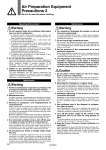
m-03-3c-seihin_en 43 / 77
10秒後にBOOKのページに移動します
Air Preparation Equipment Precautions 3 Be sure to read this before handling. Maintenance Warning Maintenance Warning 1. Perform maintenance inspection according to the procedures indicated in the operation manual. If handled improperly, malfunction and damage of machinery or equipment may occur. 2. Maintenance work If handled improperly, compressed air can be dangerous. Assembly, handling, repair and element replacement of pneumatic systems should be performed by a knowledgeable and experienced person. 3. Removal of equipment, and supply/exhaust of compressed air When components are removed, first confirm that measures are in place to prevent workpieces from dropping, run-away equipment, etc. Then, cut off the supply pressure and electric power, and exhaust all compressed air from the system using the residual pressure release function. When the equipment is operated after remounting or replacement, first confirm that measures are in place to prevent lurching of actuators, etc. Then, confirm that the equipment is operating normally. 4. If an abnormal condition occurs, turn off the power supply and stop the flow of compressed air. If an abnormal condition occurs, such as smoke, foul smell, or noise, immediately turn off the power supply, stop the flow of compressed air and set the pressure of the compressed air to zero because there is a possible risk of electrical shock or fire. 5. Do not place your hands or foreign matter inside the unit. To operate air preparation equipment (such as an air-cooled aftercooler or air dryer) in which power is supplied, do not place your hands or foreign matter inside the unit, to prevent electrical shock, burns, or injury. If the equipment must be used under such conditions due to unavoidable circumstances, turn off the power supply of the equipment, and confirm that it has stopped. Warning 1. Do not operate under the conditions listed below due to a risk of malfunction. 1) In locations having corrosive gases, organic solvents, and chemical solutions, or in locations in which these elements are likely to adhere to the equipment. 2) In locations in which sea water, water, or water steam could come in contact with the equipment. 3) In locations that are exposed to direct sunlight. (Shield the equipment from sunlight to prevent its resin material from ultraviolet ray degradation or overheating.) 4) In locations that have a heat source and poor ventilation. (Shield the equipment from heat sources to protect it from softening degradation due to radiated heat.) 5) In locations that are exposed to shocks and vibrations. 6) In locations with high humidity or a large amounts of dust. (Please contact SMC beforehand.) 2. Do not operate this equipment outdoors. The air-cooled aftercooler and air dryer have been designed for indoor use. Exposing the equipment to rain could lead to electrical shock, equipment damage, or improper operation. If the equipment must be used under such conditions due to unavoidable circumstances, please contact SMC beforehand. 3. Adhere to the specified fluid temperature and ambient temperature ranges. The fluid temperature and the ambient temperature are established according to the equipment. Using the equipment outside of its specification range could cause it to be damaged, malfunction, or operate improperly. 6. For inspection, disengage the breaker or pull out the power supply plug. To prevent electrical shock, burns, or injury during inspection, disengage the breaker or disconnect the power supply plug before inspecting the equipment. 7. Do not touch high temperature areas. Do not touch the aftercooler (through which high-temperature compressed air flows), the refrigeration unit of the refrigerated air dryer or refrigerant piping, because each generates high heat and poses a risk of burns. 8. Set the pressure of the compressed air to zero before an inspection. Before disassembling the equipment on the compressed air side for inspecting the auto drain or for replacing the filter element, confirm that the pressure is set to zero. 9. The adjustment of the safety valve and periodical voluntary inspection of the Class 2 Pressure Vessels are required by the Ordinance on Safety of Boilers and Pressure Vessels. Conduct the inspection according to the mentioned ordinance. Caution 1. Do not place a heavy object on top of an equipment or use it as a step stool. Failure to observe this precaution could cause the equipment to become deformed or damaged and a loss of balance could cause a fall or injury. 2. Discharge the drainage on a regular basis. If drain remains accumulated in the equipment or in the piping, it could cause the equipment to operate improperly, or the drain could splash to the outlet side, leading to unforeseen accidents. Therefore, check the drainage volume and the operation of the auto drain on a daily basis. 3. Additional tightening of the screws for the wire connection terminals. Depending on the operating conditions, the screws for the wire connection terminals could loosen, leading to overheating or a fire. As a preventive measure, tighten the screws on a regular basis. 4. Use sufficient care in the disposal of refrigeration type air dryers. Some refrigerated air dryers use a refrigerant that destroys the ozone layer. Please consult with a professional contractor when collecting a refrigerant or disposing of such equipment. 5. Turn off the power supply at the source if the equipment will not be used for long periods of time. To prevent accidents, turn off the power supply at the source if the equipment will not be used for long periods of time. 6. Keep the Class 2 Pressure Vessel Certificate in a safe place. Large refrigerated air dryers (lDF190D and larger) and large AFF, AMD, (AFF220A, AMD901/900/1000) and air tanks comply with Class 2 Pressure Vessel requirements. A class 2 pressure vessel certificate will be sent to you in 2 to 4 weeks after the product. Keep this certificate in a safe place. Operating Environment 38